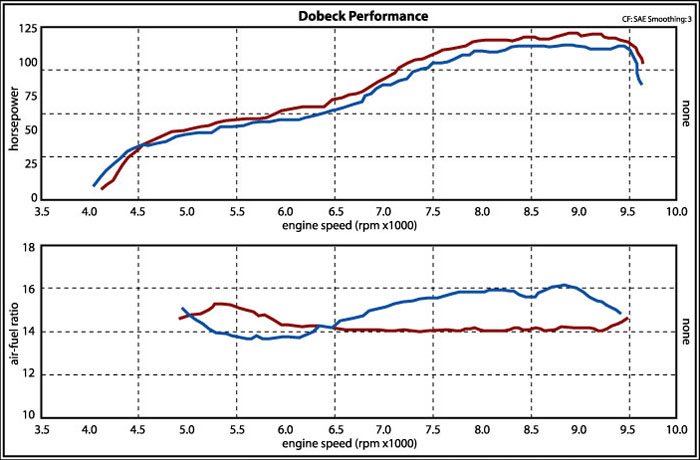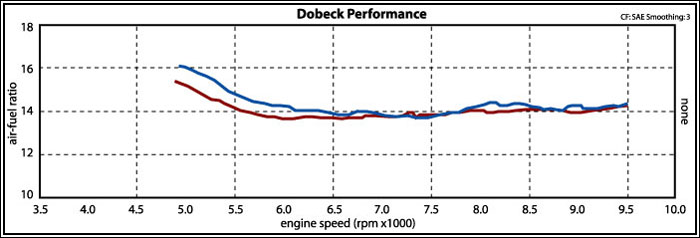HOW THE TFI FUNCTIONS
The real technology behind the TFI is that it functions like a carburetor. It takes the knowledge and experience that many of us have and converts it to a fuel injection interface. The interface starts by first understanding what signal the injectors are getting. This signal turns out to be a ground. The injector always has battery power connected to it. The ECU just sends a ground to the injector and it opens. This is just like the horn on your car. It has a steady power connected to it and when you press the button, you are giving the horn its ground and it then beeps. Now what the ECU does is give its ground to the injectors by pulsing it. What we did was read the signal by using a Fluke Meter. This is an instrument that displays what they call a square wave or duty cycle. By connecting it to the negative side, (the wire coming from the ECU to the injector) you will then notice that the injectors at idle are getting a 6-millisecond trigger. At wide-open throttle it receives a 23-millisecond trigger. That is like saying the carb has a 32.5 pilot jet and a 170 main jet. Therefore the trick is to make it work like those jets. So we drove around with our meter hooked up while noticing the size of the pulses in the same areas where the pilot and mixture screw have the most influence. Once again we documented the pulse size every time we rolled on the throttle. This represents the needle and slide speed. Finally, we measured the pulse as we shifted full-throttle through the gears. With this information, we were ready to put a pot in place of a jet change. The result is an Electronic Jet Kit. Simply figure out at what point you are having your trouble, and based on carburetor logic, determine what circuit you would adjust: pilot jet and mixture screw, needle and slide speed, or main jet. The corresponding pot in our box will change that point in the fuel delivery curve just like a carb would.

You are looking at a second and fourth gear roll-on of a stock V-ROD, fully warmed up in the above picture. Notice that not only is the horsepower different, but that the air-fuel graph is also different. Our competition would hope that you don't know this because they have RPM based technology. This means both runs are made with 100% throttle and both move through the same RPM range. Traditional map style adjustments can optimize either second or fourth, but not both. You are forever trying to get the best of both worlds, but as you can see there is a different load placed on the engine in 2nd and 4th due to torque multiplication. The load based technology of the TFI adds the proper fuel to both second and fourth gear which flattens out your fuel delivery curve.

Notice above how flat the air-fuel ratio graph is when using the TFI. The TFI is reading the different fuel demands required by the bike in different gears. This is an Electronic Jet Kit functioning just like jet kits of the past modified jet needles, needle jets, slide speed, etc. to flatten out the fuel delivery curve. When you change the main jet, you change the fuel from 1st through 6th gear. When you raise the needle up, you richen up the acceleration fuel through all engine loads. Dobeck Performance has achieved the ability to interface against the stock multi-dimensional maps to give you carburetor tuning logic.
ADJUSTING THE POTS
Green Fuel Pot: (functions like a fuel mixture screw and pilot jets on a carburetor)
Adjusts for the motorcycle's fuel requirements during light load operation, from idle through highway cruising speeds and steady throttle, at or below the rpm set by your rpm pot.
We have found that manufacturers have generally leaned out the fuel mixtures for emissions to a specific rpm (see below).
To set this pot, make sure the motorcycle is up to a full operating temperature, then while in neutral, pick a fast idle that is not easy to hold a steady rpm (V-twins 1800-2200 rpm and multiple cylinders 2500-3000 rpm), hold the throttle at that spot and then slowly and evenly turn the green pot clockwise from its minimum setting, while listening to the exhaust sound. You should hear the exhaust sound change form an irregular and uneven sound to an even and smooth one. You may also see an increase in rpm as you increase fuel, and if you continue to increase fuel past this point to where the revs start to fall back away, then you can stop and start returning the pot screw back to a point half way between where the exhaust sound first smoothed out and the point where the highest rpm starts to fall away.
Yellow Fuel Pot: (functions like an accelerator pump - needle and slide on a carburetor)
This fuel adjustment adds fuel into the fuel map whenever the throttle is opened rapidly. This pot needs to be adjusted from test riding, by performing brisk roll-ons in a specific gear, and by always starting at the exact same rpm. Try one clock position increases between roll-on tests until you can't feel any more improvement, and then go back to the last setting that improvement was noticed. Some models won't require as much fuel as others, so while increasing the yellow by one clock position increments if the motorcycle starts to decrease in throttle response, then turn the yellow back one and a half clock positions
Red Fuel Pot: (functions like a main jet on a carburetor)
This fuel adjustment adds fuel under large load conditions and is generally required when either air intake or quality exhaust system changes occur. This addition happens automatically using our unique load sensing technology, and similar to the road test procedure listed above in yellow fuel, test riding while increasing red fuel will find an optimum setting.
RPM Switch Pot:
All (except Harley/Metric V-twins)
Sets the rpm that the green fuel turns off. This adjustment is achieved by setting the pot to 4:30 o'clock for 600cc and above multi cylinder sport bikes. Each clock position of this pot equates to about 1000 rpm's, so 4,500 rpm's would be half way between 4 and 5 o'clock. Verify this setting by revving the bike in neutral and watching for the green light to go out at the chosen rpm.
All Harley and Metric V-twins
Sets the rpm that the green and yellow fuel turns off and the red (main jet) turns on. This adjustment is achieved by setting the pot to about 70% of redline (for example a Harley-Davidson Roadking redline is 5800 rpm and 4000 is 70% of redline) which would be 4:00 o'clock. Verify this setting by revving the bike in neutral and watching for the green and yellow light to go out at the chosen rpm.
INSTALLATION
Installation varies from vehicle to vehicle so instructions will have to be referenced for the different models. However, the installation is essentially the same for all vehicles. The first thing to do is locate the stock connections to the injectors. Once found then you will either tap-on to the correct wires using tee-taps or for plug-n-play installations you will disconnect the connectors and then plug directly into the TFI harness. After connecting to the injectors you'll need to determine a proper ground location to hook up the ground wire. Final step for installing is determining where to mount the TFI and zip tying the harness to the frame.
|









